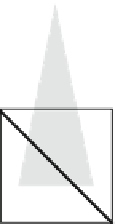Biomedical Engineering Reference
In-Depth Information
Fig. 8.3
Forward scatter
Mach-Zender interferometric
DHM configuration
Object
Microscope
Objective
Reference
Beam Lens
CCD Detector
The simplicity of point-source in-line holography is not without limitations,
however. First, restrictions must be placed on the distance between object and
pinhole in order that the interference is resolved by the CCD. Second, the assump-
tion that the interference is between scattered and unscattered wave fronts is only
reasonable for sparse objects that cover a small fraction of the field as there is
strictly no direct path from the pinhole to the detector. Finally, there are many
problems associated with numerical reconstruction which must include coordinate
transformation and nonlinear optimization methods [
32
]. The limitations of the in-
line holographic method can be overcome either by the off-axis holographic
configuration originally proposed by Leith and Upatnieks [
33
] or phase stepping
interferometry [
7
]. For the purpose of DHM the off-axis geometry has the advan-
tage that the phase and amplitude of the scattered field can be recovered from
a single interferogram.
An off-axis transmission DHM based on a Mach-Zender interferometer is shown
in Fig.
8.3
. In this configuration the microscope objective provides the necessary
magnification to ensure that the scattered field is resolved by the CCD.
The additional wave front curvature introduced by the objective can be eliminated
























Search WWH ::

Custom Search